Guitar World Verdict
While the Dirt perfectly apes Jerry Cantrell's guitar sounds, it also does a great job at plenty of other bands from the era. For the price, it's excellent value, nailing the brief and delivering a wider scope than the name suggests. You'll need a PSU to power it, but hey, it's 2025.
Pros
- +
Affordable.
- +
Easy to use.
- +
Authentic all-rounder for '90s rock.
Cons
- -
No battery option.
You can trust Guitar World
What is it?
How far does £99 get you when it comes to adding a tailored distortion to your pedalboard? You might be surprised to find out that the answer can be ‘further than you think’.
In the last few years, pedal prices and options have shot up, and now to get something outside of the mainstream Big Brand catalogues can be a costly exercise. But, that’s where Funny Little Boxes comes in.
The company started in 2020 as a retailer, but a year later, founder Andy Ilgunas picked up the gauntlet laid down by Let’s Play All Guitar’s Matt Webster to create an overdrive pedal based on the guitar tones from Pearl Jam’s Ten album, resulting in the Funny Little Boxes 1991.
It worked, and worked very well. Since then, we’ve been impressed by FLB’s pursuit of QOTSA’s guitar tones with the Skeleton Key, and now with the release of the Dirt pedal, it’s got its eyes fixed on another alternative guitar hero from the ’90s: Alice in Chains’ Jerry Cantrell.
Now, it’s arguable that listening to Alice in Chains might leave you with a question: what exactly is the Jerry Cantrell guitar tone? To me, it’s a mix of modulated clean sounds, bluesy crunch and, at times, borderline metal tones. Just as with the 1991 and Skeleton Key, the Dirt doesn’t aim to create a carbon copy of any one sound in particular, instead delivering the essence of AiC’s guitar sounds as a cross section.

That said, Cantrell and the band worked with producer Dave Jerden on Dirt, and depending on who you listen to –– and when they said it –– recollections of what gear was used to forge the overall guitar sound from both Cantrell and Jerden vary to include a mix of amps from Randall, Bogner, Marshall, Mesa/Boogie and even the infamous Rockman amp.
What is clear, though, is that Jerry’s sound on Dirt was built on the concept of blending multiple amps together for each part, using the tonal qualities of each to highlight bass, mid and treble frequencies by balancing the faders for each, with a lot of double-tracking too.
All the latest guitar news, interviews, lessons, reviews, deals and more, direct to your inbox!
So, what we’re looking for from the Dirt is a gain provider that can cover the more vintage/semi-clean side of AiC’s output, along with the more metal-leaning high gain sounds.
Similarly, Funny Little Boxes also acknowledges that the Dirt pedal lends itself to plenty of other tones from that era including Tool, Smashing Pumpkins and RATM, are we dealing with a jack-of-all-trades?
Specs
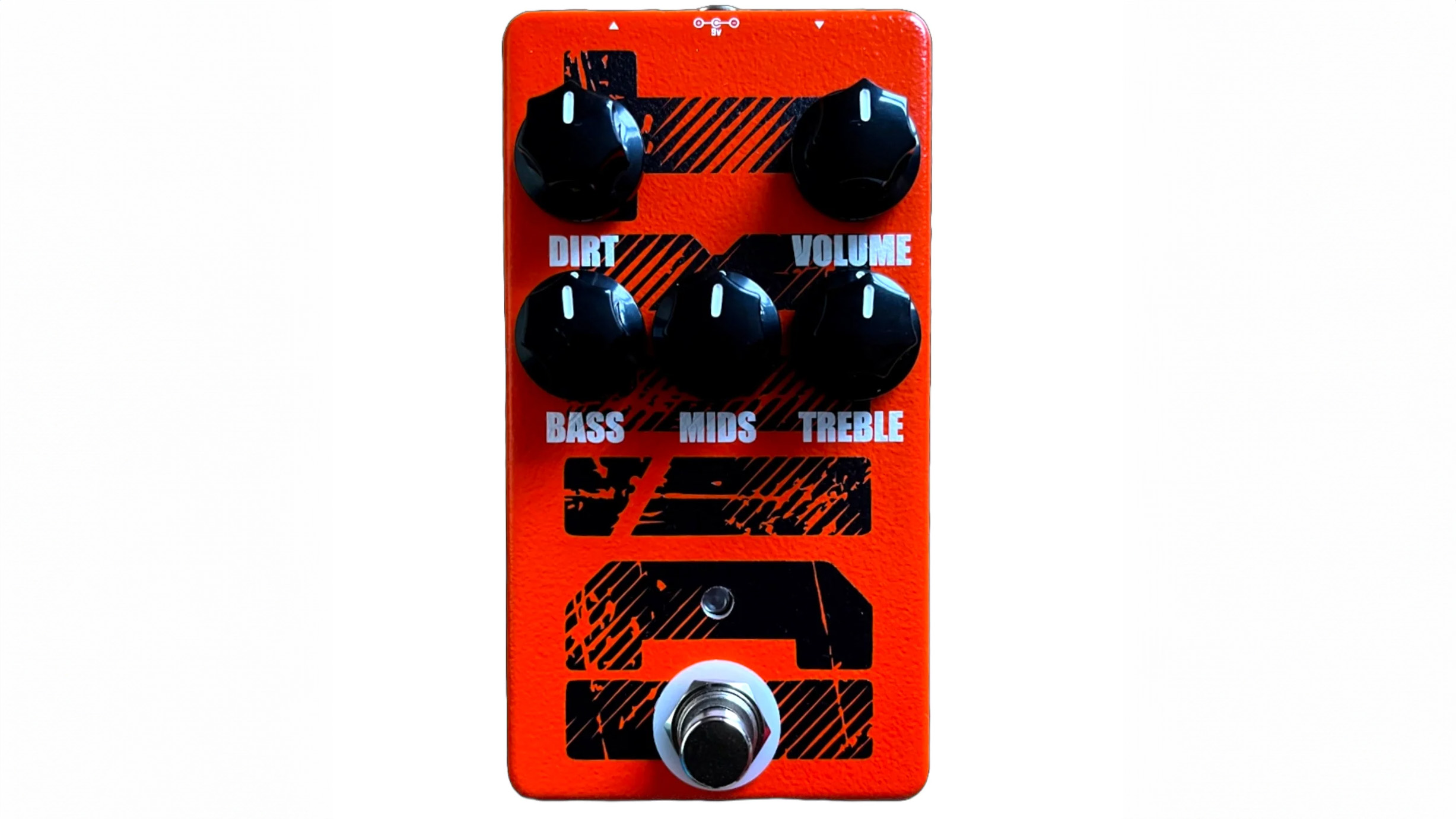
Launch price: $99/£99
Type: Distortion
Controls: Dirt (gain), Output, Bass, Middle, Treble
Features: Alice in Chains-inspired distortion in a box
Connectivity: Input, output, power
Bypass: True bypass
Power: 9-volt, 11 mA
Dimensions: 6.5x4x12.5 mm
Weight: 10.68oz/303g
Options: N/A
Contact Funny Little Boxes
Build quality

Build quality rating: ★★★★☆
The Dirt comes built into a regular die-cast aluminium enclosure/project box and is powder-coated in an orange/red hue which looks a bit like a DS-1 with the heat turned up.
The surface is textured, with the finish applied evenly, and on the underside of the pedal are four screws to gain access to the inside. It’s unlikely you’ll need to do this, though, as the Dirt runs on a PSU only, so if you’re a fan of outfitting your pedals with 9-volt PP3s (and given the abundance of pedalboard power supplies available, it’s worth investing), you’re going to need to find another way to power it.
All of the sockets and nuts are metal, which feel sturdy and inspire confidence over some affordable pedals which use plastic-barrelled jacks and fixings, and the control knobs are attached using brass screws in order to avoid them popping off easily.
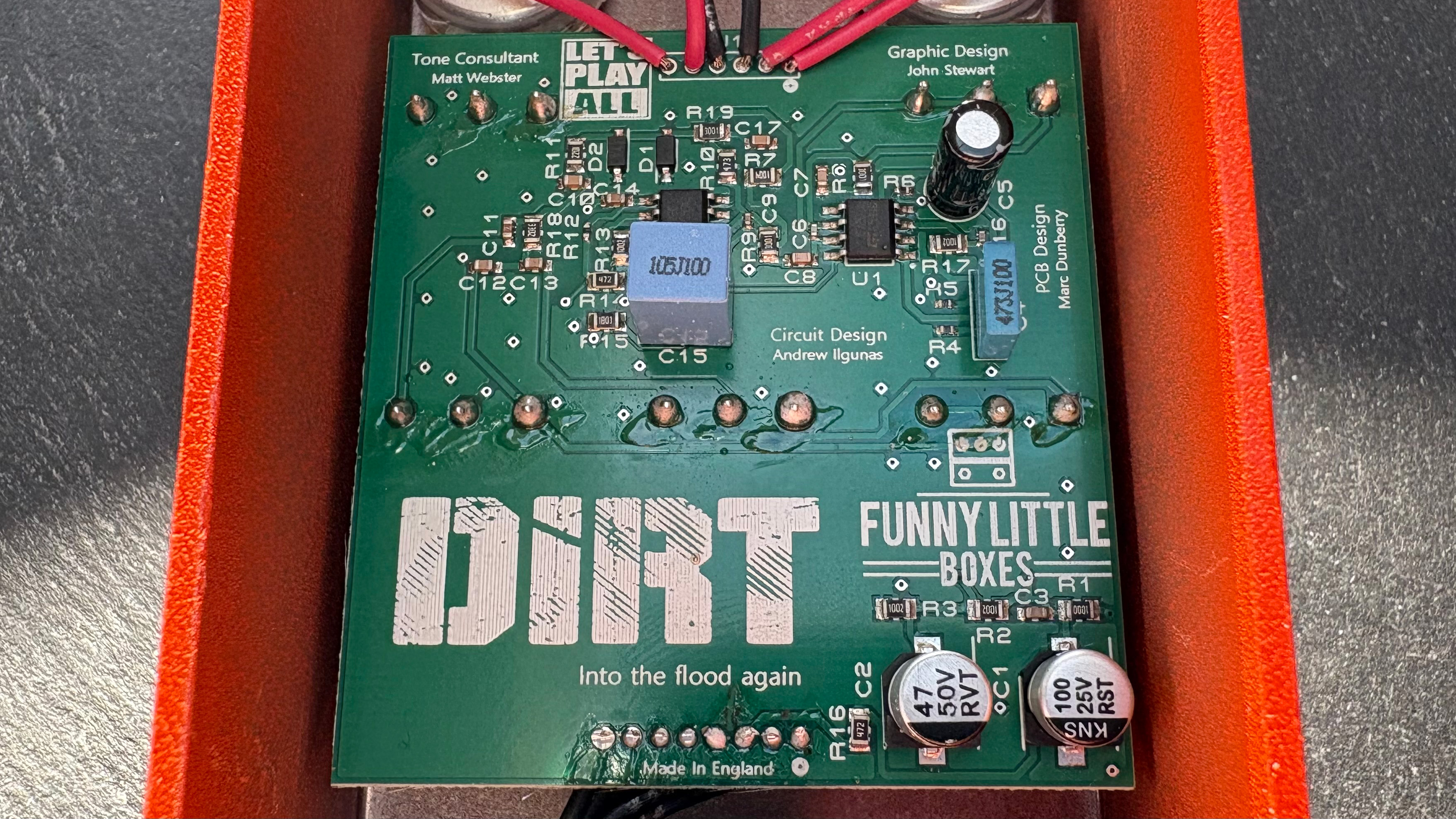
A quick peek inside reveals a neatly-made PCB, complete with the Easter egg “Into the flood again” from Alice in Chains’ Would? screened onto the board.
As well as this, there’s the FLB and Let’s Play All and Dirt logos along with credits for ‘Tone Consultant’ (LPA’s Matt Webster), PCB design (Soundlad Liverpool’s Marc Dunberry) and a nod to John Stewart who designed the tasteful Dirt graphic printed on the control face of the pedal. One of the screws took a little more care to connect to the thread, but it did reconnect smoothly.
Overall, it spans the more bespoke feel you get from a more boutique pedal and the quality we’d hope for from a mass-produced stomper.
Usability
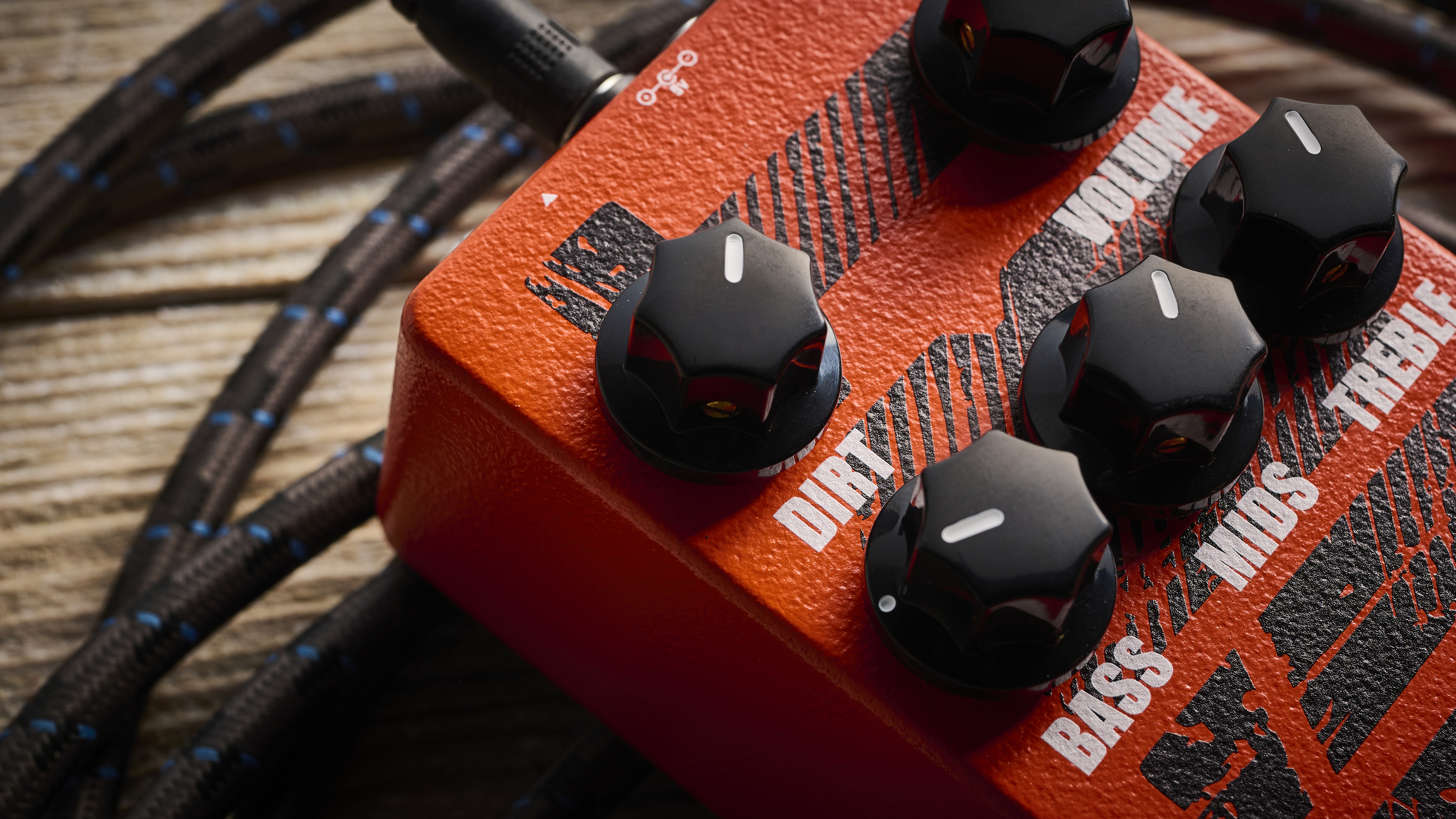
Usability rating: ★★★★½
Overall, it spans the more bespoke feel you get from a more boutique pedal and the quality we’d hope for from a mass-produced stomper
As you can see, the layout of the Dirt is quite simple: there’s a Dirt (gain) control, master volume, three-band EQ and a switch for engaging/bypassing the pedal. With top-mounted sockets, powering and routing within a pedalboard is convenient, and a simple LED lets you know whether the pedal is on or off.
The Volume pot is a logarithmic (audio) taper, so there’s a smooth, more subtle run-up to unity gain at around the 2 o’clock position, beyond which the curve becomes steeper for the rest of the control’s travel.
It’s all quite self-explanatory, but if you’re looking for setting suggestions, Matt Webster from Let’s Play All has created a video with heaps of AiC-inspired tone settings for the Dirt, as well as some non-AiC sounds which is definitely worth checking out above.
Sounds

Sounds rating: ★★★★½
Between his single-pickup G&L Rampage and Gibson Les Paul Custom, the lion’s share of Cantrell’s sounds are built on humbuckers. Armed with an HSS-loaded Strat and Les Paul Standard, I set about getting my bearings with the Dirt.
Plugged into the clean channel of a valve amp, the Dirt’s starting point with the gain at minimum begins with a crunchy overdrive. At the other extreme, you might be expecting super-saturation, but the Dirt’s gain range maxes out at a heavy rock distortion. Further proof that heavy guitar sounds aren’t solely based on an excessive blanket of gain.
Don’t expect huge low end from this pedal, if anything, cutting the control has the biggest effect
With the clipping restored to its minimum and the output at unity, experimenting with the tone controls yields some interesting results. First is that the bass control is relatively subtle. Don’t expect huge low end from this pedal, if anything, cutting the control has the biggest effect, working more like a studio-style high-pass filter to remove mud rather than imparting heaps of bass into the mix.
The treble control adds a layer of bite into the sound that remains nice and smooth for all but the most extreme settings, but the biggest surprise comes from the mid control. There’s a lot of mileage here, with a parametric-style ‘swoosh’ as we turn the control; when cut you can achieve a pretty heavy scoop that works nicely for the ’90s-style tones. But equally impressive is the breadth of frequencies present when boosting too.

Is the allure of Cantrell’s playing in the sounds or his style? I’d argue it’s a combination of both
Often, midrange controls on gain pedals can turn boxy and almost ‘radio’ effect-like at their higher settings. While the Dirt will do this, the boosted mid sounds lend some nice attack and harmonics into the sound that does a great job of –– sorry ’90s fanatics! –– going after some hot-rodded ’70s and ’80s sounds.
The EQ section all feels very interactive, particularly between the mid and treble controls, where there seems to be some overlap, so it’s definitely worth getting stuck-in.
With the gain pumped up, the Dirt does a great job of maintaining its dynamics. Pick attack remains strong and note separation is still present, making it work for beefy drop-D chord chugs alongside arpeggiated riffs alike.
I rattled my way through some of LPA’s suggested settings and the Dirt delivered. Swapping to the Strat’s single coils and pairing some chorus at lighter gain settings is a lot of fun too. It’s here that the Dirt displays its versatility, and it’s hard to argue with Funny Little Boxes’ claims. Grunge fans won’t be disappointed.
Verdict

Funny Little Boxes and Let’s Play All’s collaborations trigger the ‘collector’ part of the brain. If you grew-up in an era of physical music, and more specifically, the golden age of the ’90s, there’s every chance you’re going to want to buy the Dirt along with the two previous pedals for completism.
Where the Skeleton Key goes after a very pointed tonal flavour, it’s arguable that the Dirt is the least tailored of the trio
But, where the Skeleton Key goes after a very pointed tonal flavour, it’s arguable that the Dirt is the least tailored of the trio. It does everything it sets out to do, but does beg the question: is the allure of Cantrell’s playing in the sounds or his style? I’d argue it’s a combination of both.
Slow, lawnmower bends, discordant arpeggios, drop-D tuning and fantastic lead hooks peppered with odd timings are all part of the recipe. But throw them at the Dirt, and you’re rewarded with authenticity.
It’s pitched just right (arguably too low) price-wise, too, making it a versatile all-rounder within its fairly wide target wheelhouse. Get the tones without shelling out them bones and you’ll be onto a winner.
Guitar World verdict: While the Dirt perfectly apes Jerry Cantrell's guitar sounds, it also does a great job at plenty of other bands from the era. For the price, it's excellent value, nailing the brief and delivering a wider scope than the name suggests. You'll need a PSU to power it, but hey, it's 2025.
| Test | Results | Score |
|---|---|---|
| Build quality | It's well put together in a standard aluminium project box with quality-feeling controls. | ★★★★☆ |
| Usability | The simple control layout makes everything easy to dial in, and top-mounted sockets make it pedalboard-friendly. | ★★★★½ |
| Sounds | While it delivers on the Dirt promise, there's a lot more to this pedal than that album by that band. | ★★★★½ |
| Overall | It's a well-made, great sounding all-rounder for fans of '90s guitar tones who don't want to spend big bucks. | ★★★★½ |
Also try
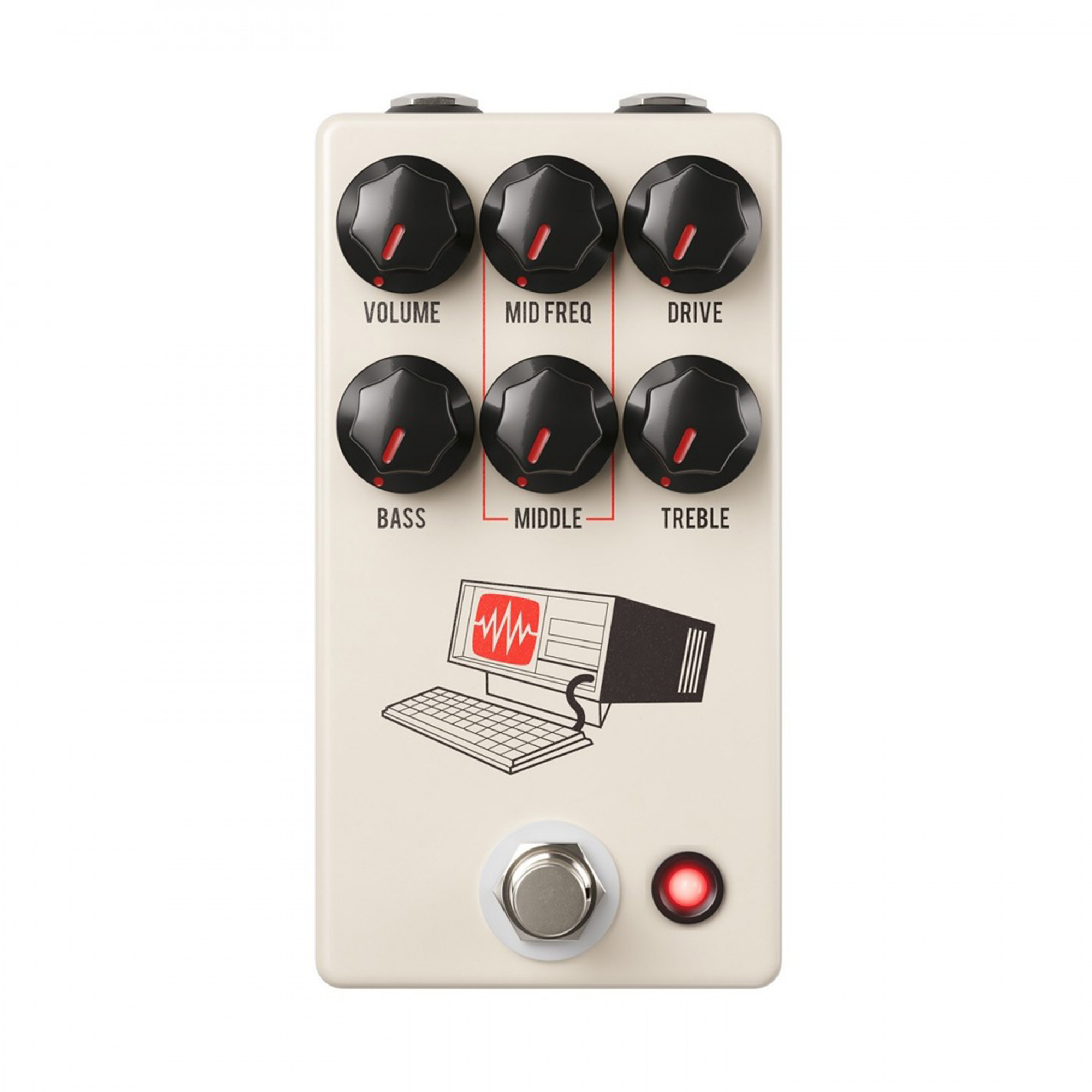
$199/£169/€219
JHS issued the Hard Drive in 2023 - the result of eight years of tinkering, it's JHS' first original distortion circuit. The aim of the Hard Drive is to capture the gamut of '90s drive sounds in one pedal. With tons of gain and comprehensive mid control thanks to the sweepable frequency range, you can dial in tight scoops or pushed mid sounds. One to check out if you come from the CD era.
Read more: JHS Hard Drive review
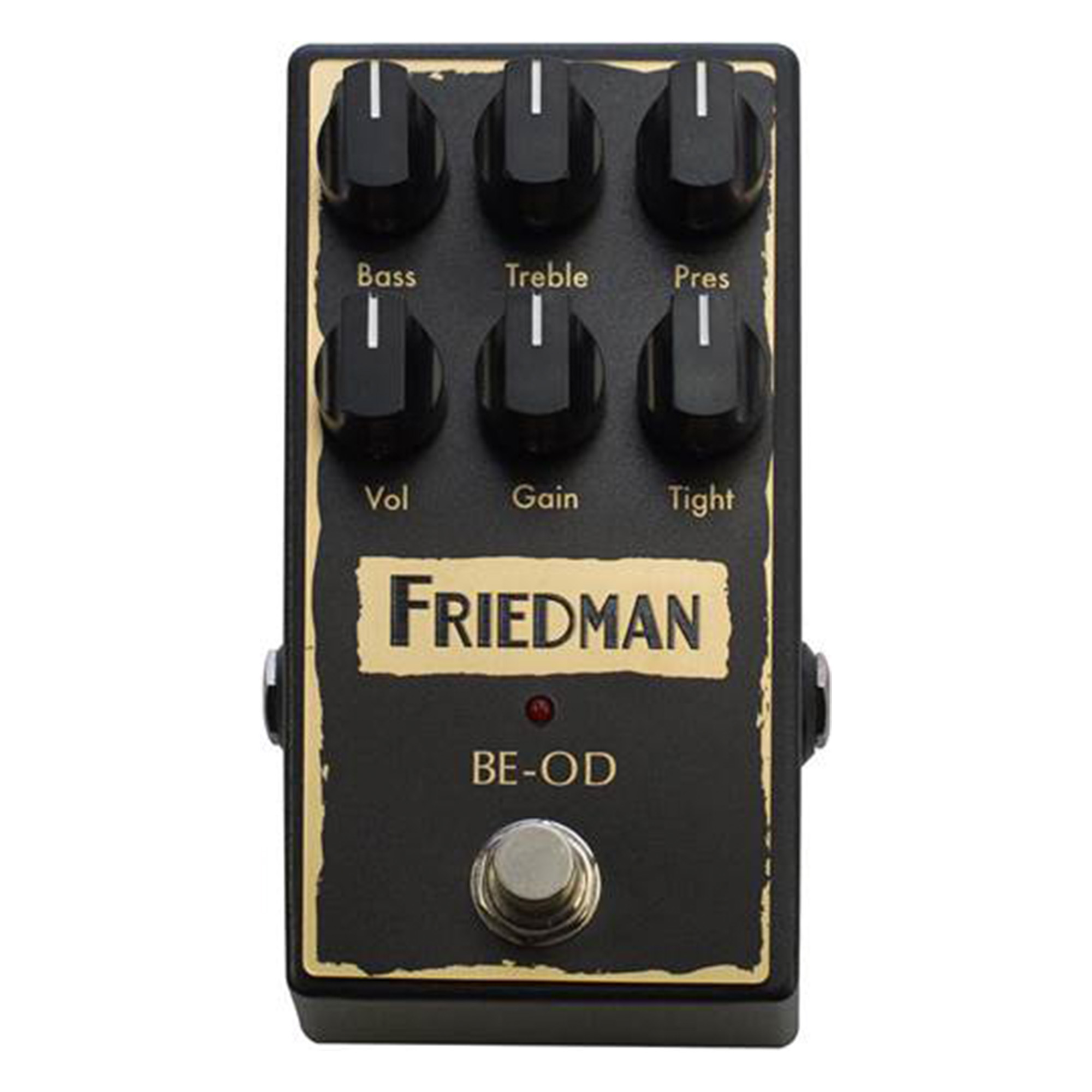
$199/£169/€200
The BE-OD from Friedman puts the beefy sound of a Friedman Brown Eye BE-100 amp into a space-saving pedal design. As well as fairly aggressive British-inspired amp-in-a-box response, you get two band EQ plus 'Tight' (pre-gain low end control) and Presence controls.
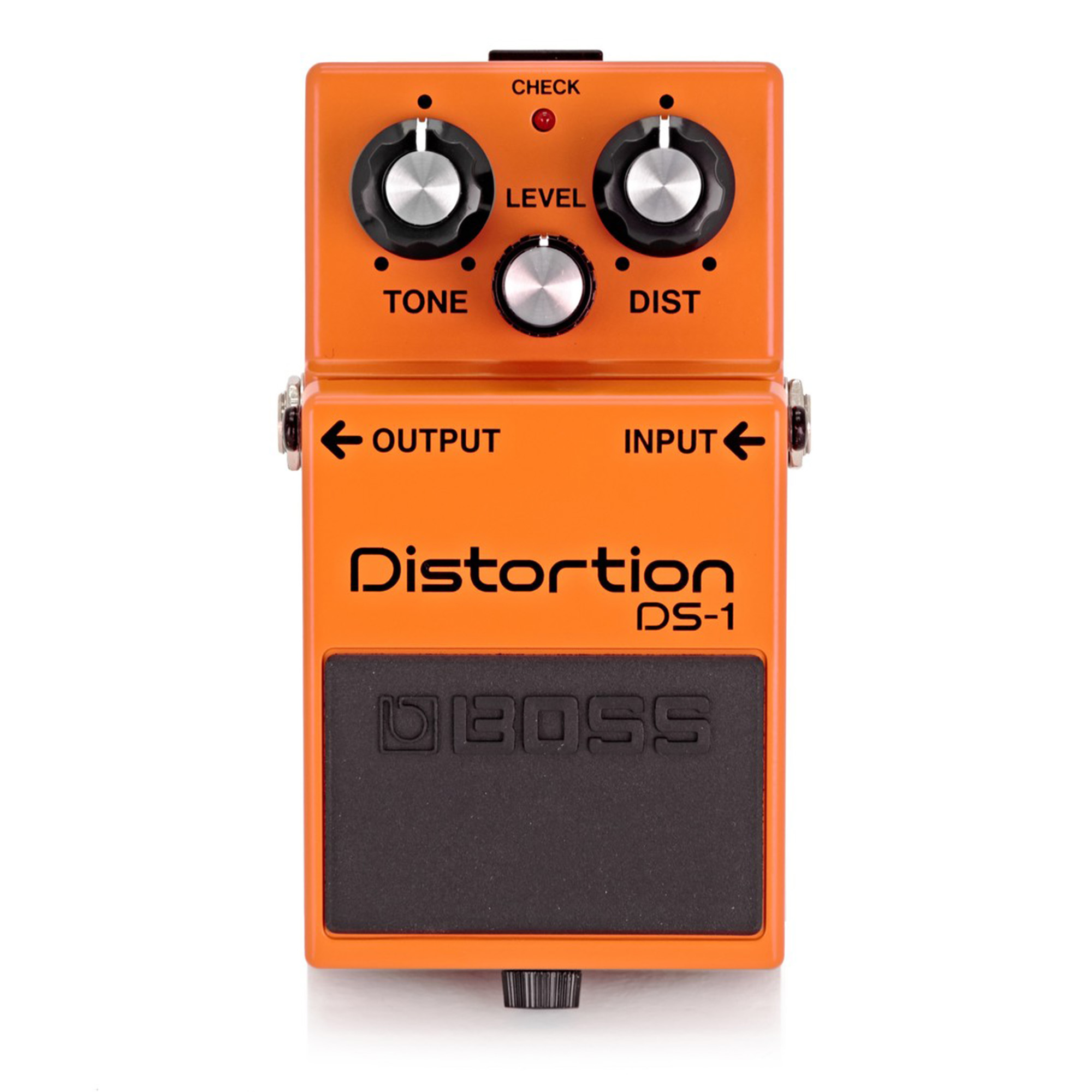
$63/£63/€76
The DS-1 from Boss has been a pedalboard mainstay for decades. With its simple control set and affordable price tag, it's a great all-rounder if you're looking for a distortion pedal to kick on for heavier sections, or provide a high-gain base to leave on. Want a little more refinement? Try the Boss Waza DS-1W.
Read more: Boss DS-1W review
Hands-on videos
Funny Little Boxes

Stuart has been working for guitar publications since 2008, beginning his career as Reviews Editor for Total Guitar before becoming Editor for six years. During this time, he and the team brought the magazine into the modern age with digital editions, a Youtube channel and the Apple chart-bothering Total Guitar Podcast. Stuart has also served as a freelance writer for Guitar World, Guitarist and MusicRadar reviewing hundreds of products spanning everything from acoustic guitars to valve amps, modelers and plugins. When not spouting his opinions on the best new gear, Stuart has been reminded on many occasions that the 'never meet your heroes' rule is entirely wrong, clocking-up interviews with the likes of Eddie Van Halen, Foo Fighters, Green Day and many, many more. If he's not playing the guitar, you'll likely find Stuart behind the kit playing Valerie to newlyweds.
You must confirm your public display name before commenting
Please logout and then login again, you will then be prompted to enter your display name.
